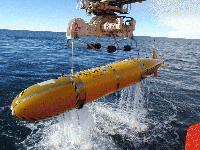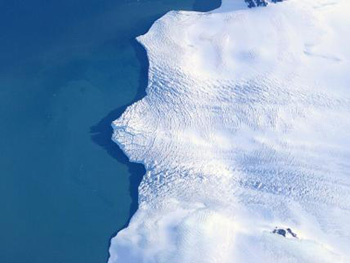搜索结果: 1-15 共查到“地球科学总论 Antarctic”相关记录16条 . 查询时间(0.072 秒)
Antarctic Circumpolar Current flows more rapidly in warm phases
ACC warm phases climate change
2021/8/4
Our planet's strongest ocean current, which circulates around Antarctica, plays a major role in determining the transport of heat, salt and nutrients in the ocean. An international research team led b...
Formulation, calibration and validation of the DAIS model (version 1), a simple Antarctic ice sheet model sensitive to variations of sea level and ocean subsurface temperature
Formulation calibration validation DAIS model simple Antarctic ice sheet model sensitive sea level ocean subsurface temperature
2014/12/19
The DCESS (Danish Center for Earth System Science) Antarctic Ice Sheet (DAIS) model is presented. Model hindcasts of Antarctic ice sheet (AIS) sea level equivalent are forced by reconstructed Antarcti...

No Longer Anchored, Antarctic Ice Stream Surges to Sea--Under-Ice Sub Finds Ridge That May Have Held Back Pine Island Glacier(图)
Antarctic Ice Stream Sea Ice Sub Back Pine Island Glacier
2010/6/22
Satellite tracking has shown that the Pine Island Glacier, one of Antarctica's largest ice streams, is accelerating and thus contributing a growing share of the melt water raising sea levels worldwide...
Natural iron enrichment around the Antarctic Peninsula in the Southern Ocean
Natural iron enrichment the Antarctic Peninsula the Southern Ocean
2010/1/21
In the Bransfield Strait, representing a mixture of waters from the Weddell Sea and the Antarctic Circumpolar Current (ACC), concentrations of DFe were ~0.4 nM and of TaLFe ~1.7 nM. The highest concen...
Natural iron enrichment around the Antarctic Peninsula in the Southern Ocean
Natural iron enrichment Antarctic Peninsula Southern Ocean
2010/1/7
As part of the US-AMLR program in January-February of 2006, 99 stations in the South Shetland Islands-Antarctic Peninsula region were sampled to understand the variability in hydrographic and biologic...
Synergistic effects of iron and temperature on Antarctic phytoplankton and microzooplankton assemblages
Synergistic effects iron and temperature Antarctic phytoplankton microzooplankton assemblages
2010/1/21
Iron availability and temperature are important limiting factors for the biota in many areas of the world ocean, and both have been predicted to change in future climate scenarios. However, the impact...

Peering Under the Ice of a Collapsing Polar Coast--Low-Level Aerial Surveys Aim to Understand Rapid Antarctic Melting(图)
the Ice of a Collapsing Polar Coast Low-Level Aerial Surveys Rapid Antarctic Melting
2009/12/10
Starting this month, a giant NASA DC-8 aircraft loaded with geophysical instruments and scientists will buzz at low level over the coasts of West Antarctica, where ice sheets are collapsing at a pace ...
Evaluation of the ground surface Enthalpy balance from bedrock temperatures (Livingston Island,Maritime Antarctic)
ground surface Enthalpy balance bedrock temperatures Livingston Island
2010/2/3
The annual evolution of the ground temperatures from Incinerador borehole in Livingston Island (South Shetlands, Antarctic) is studied. The borehole is 2.4 m deep and is located in a massive quartzite...
A new 1 km digital elevation model of the Antarctic derived from combined satellite radar and laser data–Part 1:Data and methods
digital elevation model combined satellite radar laser data
2010/2/3
Digital elevation models (DEMs) of the whole of Antarctica have been derived, previously, from satellite radar altimetry (SRA) and limited terrestrial data. Near the ice sheet margins and in other are...
Fluxes of microbes,organic aerosols,dust,sea-salt Na ions,non-sea-salt Ca ions,and methanesulfonate onto Greenland and Antarctic ice
Fluxes microbes organic aerosols dust sea-salt Na ions non-sea-salt Ca ions
2010/1/19
Using a spectrofluorimeter with 224-nm laser excitation and six emission bands from 300 to 420 nm to measure fluorescence intensities at 0.3-mm depth intervals in ice cores, we report results of the f...

Wind Shifts May Stir CO2 From Antarctic Depths--Releases May Have Speeded End of Last Ice Age—And Could Act Again(图)
Wind Shifts CO2 Antarctic Depths Last Ice Age
2009/12/10
Natural releases of carbon dioxide from the Southern Ocean due to shifting wind patterns could have amplified global warming at the end of the last ice age--and could be repeated as manmade warming pr...
Antarctic summer sea ice concentration and extent:comparison of ODEN 2006 ship observations,satellite passive microwave and NIC sea ice charts
summer sea ice concentration ODEN 2006 ship observations satellite passive microwave NIC sea ice charts
2010/2/3
Antarctic sea ice cover has shown a slight increase (<1%/decade) in overall observed ice extent as derived from satellite mapping from 1979 to 2008, contrary to the decline observed in the Arctic regi...
Bacterial diversity of autotrophic enriched cultures from remote,glacial Antarctic,Alpine and Andean aerosol,snow and soil samples
Bacterial diversity autotrophic enriched cultures glacial Antarctic Alpine and Andean aerosol
2010/1/19
Four different communities and one culture of autotrophic microbial assemblages were obtained by incubation of samples collected from high elevation snow in the Alps (Mt. Blanc area) and the Andes (Ne...
Snow melting bias in microwave mapping of Antarctic snow accumulation
Snow melting bias microwave mapping Antarctic snow accumulation
2010/2/4
Satellite records of microwave surface emission have been used to interpolate in-situ observations of Antarctic surface mass balance (SMB) and build continental-scale maps of accumulation. Using a car...
Spatial structures in the heat budget of the Antarctic atmospheric boundary layer
Spatial structures heat budget Antarctic atmospheric boundary layer
2010/2/4
Output from the regional climate model RACMO2/ANT is used to calculate the heat budget of the Antarctic atmospheric boundary layer (ABL). The main feature of the wintertime Antarctic ABL is a persiste...

